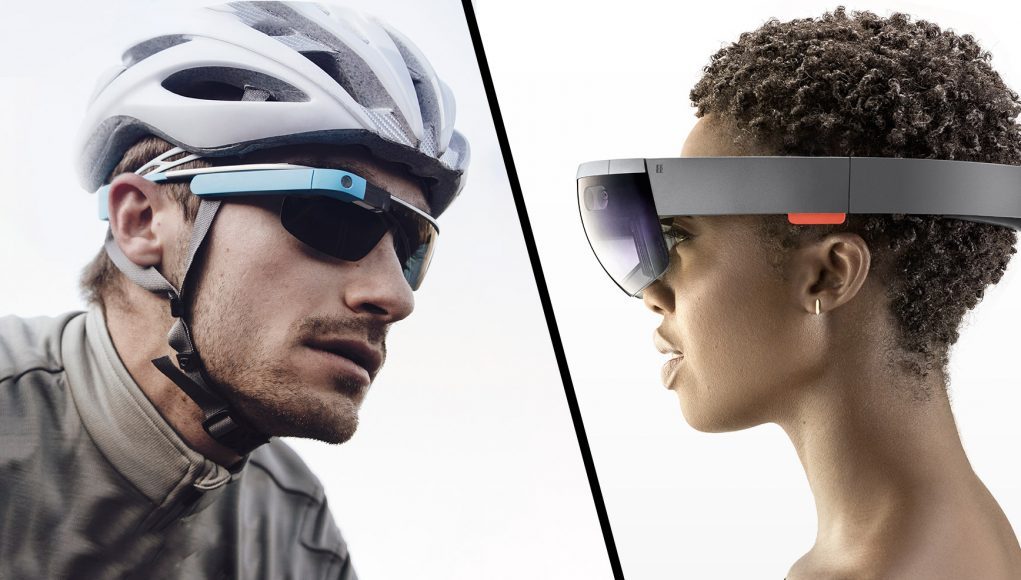2018 will see the introduction of a number of ‘smartglasses’. Initially, very few of these products will be capable of augmented reality, but many of them will be (or already are being) conflated with AR. So here’s a quick guide to understanding what augmented reality really is so that you don’t get mixed up by a hodgepodge of confusing marketing terms.
What Are Smartglasses?

Smartglasses are to glasses as smartwatches are to watches—that is, they’re a wearable device capable of presenting useful information to the user. Much like a smartwatch, that information could be a text message, your heart rate, the name of an incoming phone call, turn-by-turn directions, etc.
The benefit of smart glasses is not needing to take your eyes off of what you’re doing to see the info. In that regard, smartglasses primarily function as a head-mounted ‘heads-up-display’ (AKA HUD). This video offers a great breakdown of how information commonly presented through smartglasses:
Most smartglasses achieve this by using some type of transparent display that allows you to see a small floating screen, but simply projecting information onto a transparent screen doesn’t mean that the information is ‘augmenting your reality’, as people often conflate; in fact, many approaches to augmented reality don’t rely on transparent displays.
Examples of Smartglasses:
What Are Augmented Reality (AR) Glasses?

AR glasses go much further than simply being a head-mounted HUD; their primary function is as an augmented reality display. Augmented reality is when digital information is presented as if exists in reality. That means that smartglasses don’t become AR glasses until they’re capable of sensing the world around you to present information in such a way that it feels like it’s actually present in your reality, not simply projected onto a transparent screen. This video shows how an AR headset does more than just show static information, and actually presents what you’re seeing (in this case, a game) as if it’s actually exists in the world around you:
The reason that AR glasses are today more commonly referred to as AR Headsets is that, in order to achieve a relatively wide field of view and gather enough information about the environment to enable AR, they require significantly more complex hardware onboard (and are thus much larger). The hope of course is that AR Headsets will eventually shrink enough to be rightfully called AR glasses, but in the meantime, don’t let anyone try to sell you “AR glasses” which are really just smartglasses.
Examples of AR Headsets:
Why All the Confusion?
From my observations of AR and VR since I started writing about the technologies six years ago, there seems to be two major factors contributing to the confusion between smartglasses and augmented reality: the introduction of Google Glass, and several companies trying to redefine AR for their benefit (though both are a symptom of the simple fact that AR is difficult to envision if you haven’t actually seen it in action for yourself).
For one, AR is a feature and not a product. In fact, some smartglasses actually do have very limited AR-like functionality. Even Google Glass, one of the earliest consumer-focused smartglasses, had an app which could translate video footage of written text into different languages in real-time. Alas, even Google never called Glass “augmented reality,” since the headset was just too limited for AR to be a primary feature.
But that didn’t stop media and the public at large from calling Google Glass ‘AR’, since almost no one at the time (and many still) had a bar for what AR actually looked like in use, or realized that there’s a very complex set of challenges that need to be solved to cross the gap from smartglasses to AR glasses. Many people latched onto the term because it seemed to describe the kinds of things that Google Glass might one day do, but actually never achieved. That’s all well and good, but now that we know better, it should be quite clear that Google Glass doesn’t fall into the AR glasses category.
In many ways it was the introduction of Google Glass and its popular conflation as AR that led to much of the current confusion about the difference between smartglasses in AR. Looking to avoid rather than correct that confusion—while arguably only adding to it— some companies have repurposed other terms to describe AR. Popular among those are are ‘holographic’, ‘mixed reality’, ‘merged reality’, and we’ve even started hearing ‘extended reality’.
But unless you want a future where we’re all using different terminology for the same things, I recommend we stick to augmented reality and encourage companies adding to the confusion to do the same.
– – — – –
Making the distinction between smartglasses and AR glasses is important because the use-cases are fundamentally different. It’s the same reason we call game consoles and computers two different names; even though they’re both technically computers, they’re made to serve entirely different primary functions—making a definition so broad to encompass both is often useless to discussion except in special circumstances.







